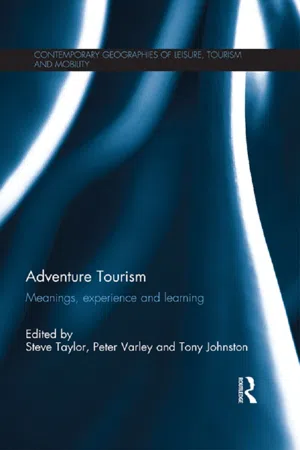
Adventure Tourism
Meanings, experience and learning
- 194 pages
- English
- ePUB (mobile friendly)
- Available on iOS & Android
About this book
Adventure tourism is an increasingly widespread phenomenon, appealing to an expanding proportion of the population who seek new destinations and new experiences.
This timely, edited volume offers new theoretical perspectives of this emerging subset of Tourism. it uses philosophical and cutting edge empirically grounded research to challenge existing thinking and develop the conceptual framework underpinning definitions of adventure, interrogating the adventure tourism experience and further building upon recent advances in adventure education. The book brings together adventure literature from range of disciplines and applies it to focused study of Adventure Tourism. By doing so it significantly furthers understanding and moves forward this development of this area of Tourism.
This significant volume is written by leading academics in the area, and will be valuable reading for all those interested in Adventure Tourism.
Frequently asked questions
- Essential is ideal for learners and professionals who enjoy exploring a wide range of subjects. Access the Essential Library with 800,000+ trusted titles and best-sellers across business, personal growth, and the humanities. Includes unlimited reading time and Standard Read Aloud voice.
- Complete: Perfect for advanced learners and researchers needing full, unrestricted access. Unlock 1.4M+ books across hundreds of subjects, including academic and specialized titles. The Complete Plan also includes advanced features like Premium Read Aloud and Research Assistant.
Please note we cannot support devices running on iOS 13 and Android 7 or earlier. Learn more about using the app.
Information
Part II Delivering the adventure experience
5 The semiotics of slow adventure
Introduction
(Hi)story
Table of contents
- Cover Page
- Half Title Page
- series Page
- fulltitle page
- Copyright Page
- Table of Contents
- illustrations
- The meaning of adventure
- PART II Delivering the adventure experience